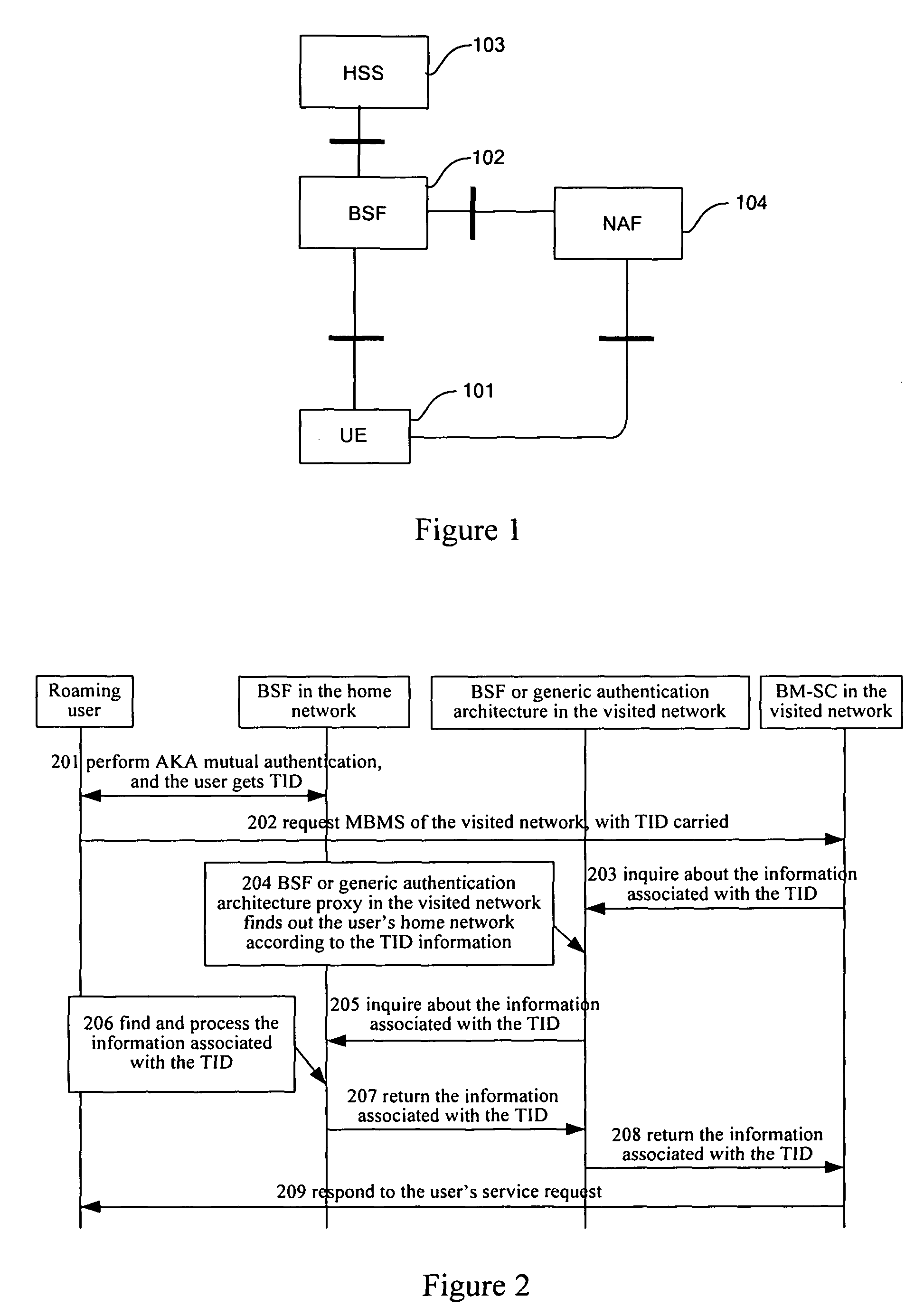Method for roaming user to establish security association with visited network application server
a security association and user technology, applied in the field of 3 g radio communication techniques, can solve the problem that the roaming user cannot use the services of the visited network, and achieve the effect of reducing the cases of authentication failure and saving resources
- Summary
- Abstract
- Description
- Claims
- Application Information
AI Technical Summary
Benefits of technology
Problems solved by technology
Method used
Image
Examples
first embodiment
[0053]FIG. 2 is the flowchart of the present invention. The application server establishes security association with the roaming user by directly inquiring about the authentication results of the generic authentication architecture of the roaming user's home network, steps are as follows:
[0054]Step 201: the roaming user carries out AKA mutual authentication with the BSF in the generic authentication architecture of his home network. After having passed the authentication, he gets the B-TID assigned by the BSF and has the shared Ks with the BSF in his home network;
[0055]Step 202: The roaming user sends service request message to the BM-SC in the visited network, with the B-TID carried in the message;
[0056]Step 203: If the visited network supports the generic authentication architecture, the BM-SC inquires about the user information associated with the B-TID to the BSF in the local network;
[0057]If the visited network only supports the generic authentication architecture proxy functio...
second embodiment
[0067]FIG. 3 is the flowchart of the present invention. The application server establishes security association with the roaming user via directly inquiring about the authentication results of the generic authentication architecture of the roaming user's home network, steps are as follows:
[0068]Step 301: The roaming user carries out AKA mutual authentication with the BSF in the generic authentication architecture of his home network. After having passed the authentication, he gets the B-TID assigned by the BSF and has the shared Ks with the BSF in his home network.
[0069]Step 302: The roaming user sends service request message to the BM-SC in the visited network, with the B-TID information carried in the message;
[0070]Step 303: The BM-SC in the visited network does not check if the user identity is legal, instead, it takes the B-TID as the user identity and directly sends an query request to the AAA server in the local network, that is, it requests the AAA server in the local network...
third embodiment
[0081]FIG. 4 is the flowchart of the present invention. The application server obtains the authentication results by performing authentication process with the generic authentication architecture of the roaming user's home network, and establishes security association with the roaming user according to the authentication results in the following steps:
[0082]Step 401: The roaming user carries out AKA mutual authentication with the BSF in the generic authentication architecture of his home network. After having passed the authentication, he gets the B-TID assigned by the BSF and has the shared Ks with the BSF in his home network;
[0083]Step 402: The roaming user sends service request message to the BM-SC in the visited network, with the B-TID information carried in the message;
[0084]Step 403: Since the BM-SC is unable to recognize the B-TID, the BM-SC notifies the roaming user that the identity is illegal, and indicates the user to use permanent identity, such as IMSI;
[0085]Step 404: T...
PUM
 Login to View More
Login to View More Abstract
Description
Claims
Application Information
 Login to View More
Login to View More - R&D
- Intellectual Property
- Life Sciences
- Materials
- Tech Scout
- Unparalleled Data Quality
- Higher Quality Content
- 60% Fewer Hallucinations
Browse by: Latest US Patents, China's latest patents, Technical Efficacy Thesaurus, Application Domain, Technology Topic, Popular Technical Reports.
© 2025 PatSnap. All rights reserved.Legal|Privacy policy|Modern Slavery Act Transparency Statement|Sitemap|About US| Contact US: help@patsnap.com



